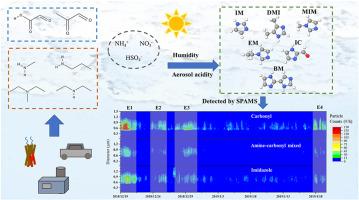Atmospheric Imidazole Formation: Unraveling the Roles of Precursors, Humidity, and Aerosol Acidity
IF 7.3
2区 环境科学与生态学
Q1 ENVIRONMENTAL SCIENCES
引用次数: 0
Abstract
To analyze the physicochemical properties and formation mechanisms of atmospheric imidazole-containing particles, a single-particle aerosol mass spectrometer (SPAMS) was employed to sample particulate matter in a major city in eastern China from December 19, 2018, to January 19, 2019. Throughout the monitoring period, particles containing carbonyls (183,952), amines and carbonyls (64,019), and imidazole (120,429) were collected. Four pollution episodes (E1-E4) and three clean periods (C1-C3) were identified based on increases in dominant precursor carbonyl particle concentrations. During pollution episodes, carbonyl-containing, amine-carbonyl mixed and imidazole-containing particles increased by 79.4%, 43.3%, and 61.9% on average, respectively. Relative humidity between 50%-70% and aerosol acidity in the range of 20-30 facilitated the conversion of carbonyl and amine/ammonium precursors into imidazole. Notably, glyoxal and methylglyoxal exhibited higher uptake rates under RH < 70%. Precursor particles peaked during the daytime. Imidazole particle concentrations were elevated at night, reflecting reduced photolysis and contributions from secondary formation processes. Principal component analysis (PCA) identified four factors, explaining 81.0% of the total variance. PC1 (41.0%) revealed C2HO3-, NH4HSO4, and DEA as key precursors. Factor loading analysis across different periods revealed that imidazole formation is a multi-factor process influenced by precursor composition and environmental parameters.

大气中咪唑的形成:揭示前体、湿度和气溶胶酸度的作用
2018年12月19日至2019年1月19日,利用单粒子气溶胶质谱仪(SPAMS)对中国东部某主要城市大气中含咪唑粒子的物理化学性质及其形成机制进行了分析。在整个监测期间,收集到含有羰基(183,952)、胺和羰基(64,019)以及咪唑(120,429)的颗粒。根据主要前体羰基颗粒浓度的增加,确定了4个污染期(e1 ~ e4)和3个清洁期(c1 ~ c3)。在污染时段,含羰基、胺羰基混合和咪唑颗粒分别平均增加79.4%、43.3%和61.9%。相对湿度在50% ~ 70%之间,气溶胶酸度在20 ~ 30之间,有利于羰基和胺/铵前体转化为咪唑。值得注意的是,在RH <; 70%下,乙二醛和甲基乙二醛的吸收率更高。前体粒子在白天达到峰值。咪唑颗粒浓度在夜间升高,反映了光解作用的减少和次生形成过程的贡献。主成分分析(PCA)确定了四个因素,解释了总方差的81.0%。PC1(41.0%)显示C2HO3-、NH4HSO4和DEA是关键的前体。不同时期的因子负荷分析表明,咪唑的形成是一个受前体成分和环境参数影响的多因素过程。
本文章由计算机程序翻译,如有差异,请以英文原文为准。
求助全文
约1分钟内获得全文
求助全文
来源期刊

Environmental Pollution
环境科学-环境科学
CiteScore
16.00
自引率
6.70%
发文量
2082
审稿时长
2.9 months
期刊介绍:
Environmental Pollution is an international peer-reviewed journal that publishes high-quality research papers and review articles covering all aspects of environmental pollution and its impacts on ecosystems and human health.
Subject areas include, but are not limited to:
• Sources and occurrences of pollutants that are clearly defined and measured in environmental compartments, food and food-related items, and human bodies;
• Interlinks between contaminant exposure and biological, ecological, and human health effects, including those of climate change;
• Contaminants of emerging concerns (including but not limited to antibiotic resistant microorganisms or genes, microplastics/nanoplastics, electronic wastes, light, and noise) and/or their biological, ecological, or human health effects;
• Laboratory and field studies on the remediation/mitigation of environmental pollution via new techniques and with clear links to biological, ecological, or human health effects;
• Modeling of pollution processes, patterns, or trends that is of clear environmental and/or human health interest;
• New techniques that measure and examine environmental occurrences, transport, behavior, and effects of pollutants within the environment or the laboratory, provided that they can be clearly used to address problems within regional or global environmental compartments.
 求助内容:
求助内容: 应助结果提醒方式:
应助结果提醒方式:


